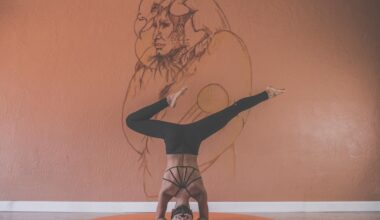Dynamic vs. Static Stretching: What’s Best for Injury Prevention?
Understanding the difference between dynamic and static stretching is essential for effective injury prevention in sports and physical activities. Dynamic stretching involves moving parts of your body through a full range of motion, often mimicking the movements you will perform in your activity. This method warms up your muscles and increases blood flow. On the other hand, static stretching consists of holding a stretch for a specific period, typically around 15 to 60 seconds. While both methods have their place, the timing of their use is crucial. Dynamic stretching is best suited for pre-activity warm-ups as it prepares muscles for action, preventing injuries. Static stretching is generally recommended for cooling down after exercise, helping to promote flexibility and relaxation. Understanding when to use each type will significantly contribute to overall flexibility and mobility. In terms of injury prevention, knowing your body’s needs can help optimize your routines. For those involved in high-intensity activities, dynamic stretching is pivotal to enhance performance. In contrast, athletes may benefit from static stretching after workouts, making sure to integrate both methods effectively for optimal injury prevention.
Dynamic stretching offers several benefits that specifically target injury prevention and improve mobility. These stretches typically involve continuous movement, engaging various muscle groups and preparing them for more strenuous activity. By increasing muscle temperature, blood flow, and overall flexibility, dynamic stretching significantly reduces the risk of strains or tears. Examples of dynamic stretches include walking lunges, leg swings, or arm circles. Each of these movements not only helps improve flexibility but also enhances coordination and balance, which are vital elements in preventing injuries during sports. Integrating these stretches into warm-up routines assists athletes and fitness enthusiasts in preparing their bodies for physical demands. Moreover, dynamic stretching enhances performance, helping athletes achieve better results in their respective activities. Research has shown that preparing the body with dynamic stretches can lead to improved muscular strength and better control during movements. As such, individuals are advised to emphasize their warm-up sessions with dynamic stretches to safeguard against injuries. This method can be further fine-tuned to focus on specific areas needing attention, ensuring a comprehensive approach to movement preparation.
The Role of Static Stretching
While dynamic stretching is crucial before physical activity, static stretching plays an equally important role in injury prevention and recovery. Static stretches, which involve holding a muscle in a stretched position, can help maintain or improve flexibility. Flexibility is a key component in preventing injuries since tight muscles are more prone to strains during unexpected movements. Holding stretches post-activity can also aid in muscle relaxation and recovery. For the best results, individuals should target specific muscle groups engaged during their workouts or sports. Typical static stretches include seated hamstring stretches, quadriceps stretches, and shoulder stretches. These positions allow muscles to lengthen and relax, providing a counterbalance to the tightening that occurs during intense physical activity. While static stretching is not recommended before high-intensity tasks due to potential short-term reductions in strength, it is vital for post-exercise recovery. Incorporating a dedicated stretching routine after workouts can significantly help alleviate soreness, enhance overall flexibility, and contribute to better mobility over time. Hence, static stretching should not be overlooked in a balanced approach to injury prevention.
Combining dynamic and static stretching creates a well-rounded approach to flexibility and mobility. Knowing the benefits of each allows you to optimize your routine based on your individual needs and activity. For example, before a run or a game, incorporating 10 to 15 minutes of dynamic stretching can activate your muscles effectively. This warm-up should focus on major muscle groups and movements specific to your sport. Post-activity, transitioning into a cool-down phase that includes static stretching can provide significant recovery benefits. Targeting areas of tightness and discomfort helps restore flexibility and reduces muscle soreness. Furthermore, the integration of both stretching types teaches the body to move efficiently, improving overall athleticism. It also aids in developing proper techniques that minimize injury risk. Ultimately, the goal of including both dynamic and static stretches is to create a balanced routine that prepares the body, protects against injuries, and promotes long-term mobility. Athletes and active individuals should strive to educate themselves about their bodies and how best to incorporate these stretching methods into their normal training schedules for optimal performance.
Key Points for Injury Prevention
To truly harness the benefits of dynamic and static stretching for injury prevention, certain key points must be considered. First, it’s essential to differentiate between the two types of stretching and utilize them appropriately during training sessions. Dynamic stretching should always precede high-intensity activities, while static stretching should follow intense exercise. Additionally, it is crucial to listen to your body and recognize signs of tightness, fatigue, or discomfort. If specific muscle groups are consistently tight, they may require more attention in your stretching routine. Incorporating targeted stretches for individual needs can significantly improve flexibility and mobility over time. Furthermore, maintaining a consistent stretching routine is vital; flexibility improves with regular practice. Lastly, staying hydrated and nourished will help maintain muscle elasticity, further contributing to injury prevention. Overall, knowledge, awareness, and proper technique form the foundation of an effective injury prevention strategy. Athletes should not overlook these factors, as they play a direct role in their long-term athletic performance and health. Regularly reviewing and adjusting your stretching regimen is key to achieving these goals.
In summary, the interplay between dynamic and static stretching is essential for enhancing flexibility, mobility, and injury prevention. Each method serves unique purposes that, when applied correctly, can yield significant benefits. Dynamic stretching prepares muscles for activity while static stretching aids in recovery and flexibility improvements. Together, they create a synergistic relationship that maximizes athletic performance and reduces the risk of injuries. Establishing a balanced routine that incorporates both stretching methods ensures that individuals can not only prevent injuries but also enhance their physical capabilities. Recognizing personal goals and activities is vital. Athletes should tailor their stretching routines to specific demands of their sport, consistently reevaluate their progress, and make adjustments as necessary. This continual improvement allows for sustainable success and injury-free performance. By investing time in developing a structured stretching regimen, active individuals will enjoy the rewards of greater agility, strength, and overall well-being. In addition, seeking guidance from knowledgeable coaches or therapists can provide further insights and boost the effectiveness of your stretching practices. This holistic approach to injury prevention is instrumental in promoting lifetime mobility and flexibility.
Conclusion: Making the Right Choice
Determining the best stretching method for injury prevention ultimately lies in understanding your activity and personal needs. Engaging with both dynamic and static stretching equips individuals with the tools necessary to enhance their performance while safeguarding against injuries. Remember, dynamic stretching is best for pre-activity warm-ups, promoting blood flow and readiness. In contrast, static stretching should be prioritized post-activity, contributing to muscle recovery and long-term flexibility. The choice between these two methods should not be seen as either-or; rather, they should be seen as complementary strategies in a comprehensive fitness plan. Tailoring your routine to uphold these principles will ensure you maximize the benefits of stretching. Additionally, monitoring your progress ensures that your strategy continues to fit your evolving needs. By being mindful of injuries and the areas of your body that may require specific focus, you can better prepare yourself for the upcoming demands of your activities. Ultimately, cultivating a balanced approach leads to happier, healthier muscles and the ability to enjoy sports while minimizing injury risk. Consistent practice, self-awareness, and adjustment are key to successful injury prevention.
As a final note, individuals should remember that the journey to optimal flexibility and mobility is ongoing. Listening to your body and adapting your practices is essential in finding the right balance between dynamic and static stretching. Therefore, consider dedicating time not just to executing the stretches but also to understanding their mechanics and how they benefit your body in various activities. Consistently re-evaluating your approach can lead to the discovery of new techniques, stretches, or insights tailored to your needs. Therefore, remaining proactive and knowledgeable will enable you to engage better with your chosen sports or workouts while promoting overall health. Additionally, collaborating with trainers or physical therapists can provide personalized recommendations and further enrich your routine. At the end of the day, it’s about finding what works best for you, preventing injuries, and enjoying activities with confidence. Striking this delicate but rewarding balance will lead not only to improved performance but also ensure a long-lasting enthusiasm for your physical pursuits. With diligence and mindful practice, you can embrace the full benefits of both dynamic and static stretching to reach your goals.


